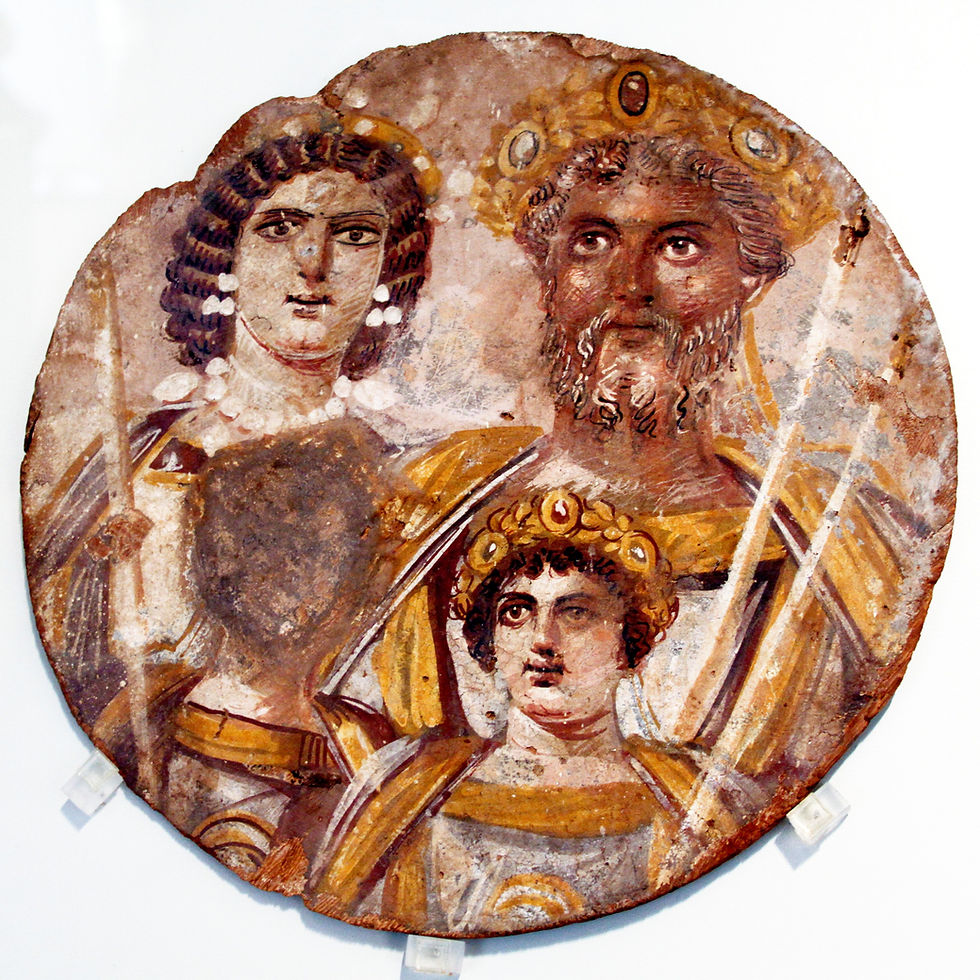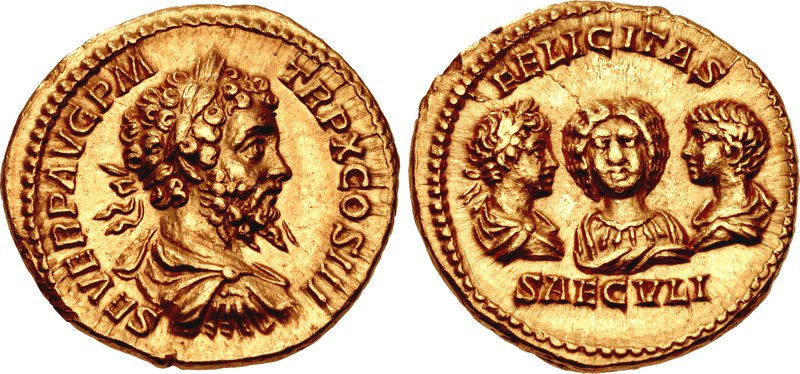The Real Severans III: Fraternal Face-off - Damnatio and the Severan Tondo
- ptcrawford
- Aug 17
- 7 min read

In looking at the demise of Geta, we saw how the second generation of the imperial Severan dynasty did not get along at all. Unsurprisingly, Septimius Severus was not keen to portray that dissension; indeed, he wanted the opposite, even if it was untrue. Such positive (and unrealistic) imperial propaganda is most clearly seen on what is called the Severan Tondo (also known as the Berlin Tondo), a contemporary panel painting of the two generations of the imperial family - Severus himself, his wife Julia Domna, and their two sons, Caracalla and Geta.
While this is an exceedingly rare to have such a striking tempera painting survive over 1,800 years, perhaps the most striking about it is something that has not survived... the face of one of the brothers has been deliberately destroyed, with the resultant void even being smeared with faeces (unique amongst surviving preserved portraits). This was an act of image destruction carried out as part of the practice later known as damnatio memoriae - ‘damnation of memory’.

As Geta is recorded being the subject of such an erasure on the order of his brother - his statues destroyed or transformed, his coins melted down, his name scrapped from inscriptions, his face obliterated anywhere it was found - it is most frequently thought that it is Geta’s face that has been deliberately removed from the Severan Tondo (for an outline of the Severan Tondo, Varner (2004) 181-182, who holds that it is Geta’s face ruined).
However, to this admittedly untrained eye, there appears at least some reason to suggest that it was not Geta whose face has been removed from the Tondo, but that of Caracalla (cf. Metzler (1973) 17-18). While Geta did face an officially sanctioned damning of his memory in the wake of his murder in 211, following his own murder in 217, Caracalla did face some limited removal of his statues due to Macrinus looking to placate the Senate, which hated Caracalla, but not wanting to annoy the army, with which Caracalla remained immensely popular (HA Macrinus 7.4; Dio 78.19.2). This meant that “any destruction of Caracalla’s monuments occasioned by de facto measures or spontaneous demonstrations against Caracalla’s memory was very limited in scope” (Varner (2004) 184), but it was not non-existent.
The perspective of the portrait makes it seem like it is the taller boy who has had their face removed and as Caracalla was the elder, we would expect him to be depicted as taller than Geta. However, attempting to decipher identities from positions in a portrait is fraught with danger, not least due to the projecting of more modern notions back onto the late 2nd century AD. It is also difficult to build up a picture of Roman family portrait norms when so few have survived, but just because we might expect a family portrait to be arranged by ascending height, age or seniority front to back does not mean that Roman portraiture followed the same rules, particularly when there are imperial individuals involved. Indeed, there is clear evidence of the lack of such thinking in this very portrait, with Severus standing in front of Julia Domna. This was at least partly because he is the paterfamilias of not just his family but of the entire Roman state.

And such portraiture concerns with rank may not be limited just to the husband/wife and/or emperor/empress relationship of Severus and Julia Domna with regard to the Severan Tondo. Both boys appear similarly garbed and adorned, but this may not be correct in terms of their rank. Given the youth of the still visible face on the Tondo, it is surely depicting the family well before Geta’s elevation to Augustus when he was 20 years old. And unless it is from before 195, when neither brother held imperial rank (and when Caracalla would have been around 7 and Geta barely 6), this portrait is from a time when Caracalla and Geta were not of the same imperial rank.
Caracalla was Augustus by the age of 9 on 28 January 198, and while Geta was made Caesar on the same day, he was not elevated to Augustus until late 209. And as Caracalla had been Caesar since 195/196, the brothers were therefore not of the same imperial rank throughout the period c.195-209, and so should not be depicted in the same garb and adornments (we might also suggest that such a disparity in rank may have affected their relationship, with Geta annoyed at his lesser position, and Caracalla then resenting no longer being rank senior to Geta after 209).
It was certainly a trend in imperial mosaics of later centuries to see the emperor placed in front of his military, political and familial subordinates, even if it was solely indicated by the feet of Justinian I in San Vitale and Constantine IV in Sant’ Apollinaire in Classe being on top and therefore in front of the figures immediately beside them.
It would therefore make more (Roman) sense for the Augustan Caracalla to be further forward than the Caesarian Geta in a portrait featuring them both. It might also make more sense for Caracalla to be in front of and therefore more directly associated with his father, who was his senior in age and height but likely his equal in Augustan rank.
With all that said, we might ask if the Severan Tondo really reflects a singular chronological or imperial reality? Was it really meant to depict the imperial family of c.200 with all aspects of their personal rank, beyond Severus being clearly the emperor and that his succession was secure? Any such lack of specificity could takeaway some of the certainty that the surviving face is that of Caracalla.
Indeed, the defacer of the Tondo themselves may well have been guessing which son was which, regardless of who he was really targeting. We might even suggest that with the damage above the surviving boy’s right eye (as the viewer looks), there was some indecision. Or was there a proposed second bout of damnatio that was not completely fulfilled? Or there was just some damage accrued during the intervening centuries.
The geographic origin of the Tondo together with an historical act of Caracalla could provide some backing to the idea that it is Caracalla, not Geta, who has been obliterated. Being so similar in materials and style to the later mummy portraiture from Fayum in Egypt, it seems likely that the Severan Tondo shared such Egyptian origins. How this might connect to the mutilation of the Severan Tondo is through the actions of Caracalla at the outset of his Parthian campaign. In 215, Caracalla visited Alexandria in order to pay his respects to Alexander the Great at his tomb. But part of this visit was seemingly also to punish the Alexandrians for insulting him. This saw the emperor carry out a vast massacre of city leaders, inhabitants and visitors (Dio 78.22.2-23.1-3; Herodian IV.9.1-8).
“in spite of the immense affection which he professed to cherish for Alexander, all but utterly destroyed the whole population of Alexander’s city”
Dio 78.22.1
“So great was the slaughter that the wide mouths of the Nile and the entire shore around the city were stained red by the streams of blood flowing through the plain”
Herodian IV.9.8
The only specific reason actually put forward by Dio for this massacre was Caracalla’s anger at Alexandrians professing their dislike of Geta’s murder (Dio 78.22.1), while Herodian states that it was reported to Caracalla “that the Alexandrians were making endless jokes about him” (Herodian IV.9.2), focusing on the murder of Geta, his relationship with his mother and his pretending to be Alexander, which caused “the naturally savage and quick-tempered Caracalla to plot their destruction” (Herodian IV.9.3). Such was the glee that Caracalla felt in the perpetrating that he embraced the nickname ‘beast’ connected to an oracle prediction about him (Dio 78.23.4).
This massacre will have left bad feeling amongst the Alexandrians and wider Egyptians, and if the Tondo was made there, this would be a logical basis for the idea that it was Caracalla’s face that was obliterated and smeared with faeces (cf. Metzler (1973) 17-18). Plus, if this was Caracalla’s face that was destroyed, that would mean that the face of Geta, who had been victim of an official damnatio memoriae, had not been destroyed in the Severan Tondo. And if is this tondo was being used in a public setting as an icon of the imperial family, could it be that it reflects Alexandrian/Egyptian support for Geta? Such support or failure to fulfil Caracalla’s orders over the damnatio could have helped spark the Alexandrian massacre of 215. The Alexandrian ridicule of Caracalla for the murder of Geta might seem like it could come from an avenue of support for Geta, adding some stock to the suggestion that it is not Geta’s face destroyed on the Tondo; however, the ridicule seems to come more from a more general Alexandrian penchant for “jesting at the expense of those in high places” (Herodian IV.9.2).
Ultimately, we are dealing with significant guesswork in trying to overturn the almost overwhelming opinion that it is Geta, the victim of an official damnatio memoriae, who has had his face removed from the Severan Tondo. While in theory Caracalla being the seemingly taller boy and/or Geta being the youngest might seem to dictate their position in the portrait, our modern preconception of what those positions should be do not necessarily link up with the ‘rules’ of Roman portraiture or the depiction of imperial rank in the 2nd/3rd century AD. And while the Alexandrian massacre might provide a good reason for Caracalla’s face to be ruined to such a degree, faeces and all, on a tondo that almost certainly came from Egypt, that by no means proves anything… even if this author cannot completely shake his initial thought of it being Geta who has survived on the Severan Tondo…
Bibliography
Baharal, D. ‘The Portraits of Julia Domna from the Years 193-211 A.D. and the Dynastic Propaganda of L. Septimius Severus’, Latomus 51 (1992) 110-118.
Haeckl, A.E. ‘Brothers or Lovers? A New Reading of the “Tondo of the Two Brothers”’, The Bulletin of the American Society of Papyrologists 38 (2001) 63-78.
Metzler, D. ‘Bilderstuerme und Bilderfeindlichkeit in der Antike’, in Warnke, M. (ed.) Bildersturm: Die Zerstörung des Kunstwerks. Munich (1973) 14-29.
Varner, E.R. Mutilation and Transformation: Damnatio Memoriae and Roman Imperial Portraiture. Leiden (2004).


Comments